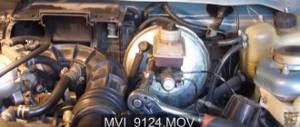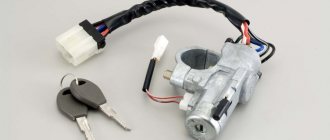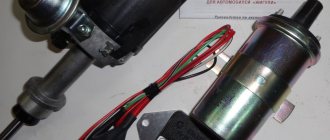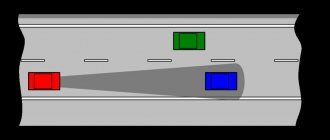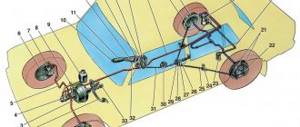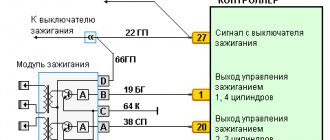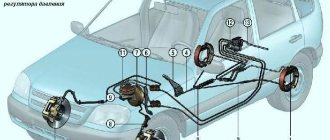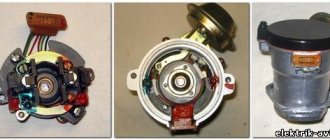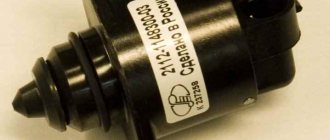Purpose of the brake booster
The vast majority of modern cars use a hydraulic braking system. It implies that the force required to compress the brake pads is created by the driver himself when pressing the brake pedal. Through the master cylinder, force is transmitted to the brake cylinders located on the wheels using an incompressible fluid. The force is transmitted from the cylinders to the brake pads, which perform braking.
The disadvantage of a hydraulic braking system is that the driver must apply quite a lot of force to compress the brake pads. In addition, the required force depends on the weight of the vehicle and increases with increasing speed at which braking occurs. During a long trip or driving in city mode, the brake pedal can be pressed tens or even hundreds of times, which leads to rapid fatigue of the driver. And this can already affect traffic safety.
The purpose of the vacuum brake booster lies in the very name of the part. It is designed to increase the force exerted by the driver when transmitting the impact to the brake cylinder and further to the brake pads. The vacuum booster increases the pressing force several times, which makes braking more effective and reduces physical stress on the driver.
The brakes stopped working
In the worst case scenario, the brake booster control valve fails completely, resulting in complete inoperability of the brake system. Fortunately, such an outcome is unlikely. But if suddenly it does occur, carefully stop the car, tow it home and contact a qualified specialist in the diagnosis and repair of brake systems. Depending on the severity of the case, the matter may be limited to only replacing the valve, but serious repairs of the entire brake system may be required.
The brake booster control valve is an important element of the braking system, ensuring driving safety. That is why the presence of the described symptoms should not be ignored or postponed “for later”. Contact a qualified mechanic who can professionally diagnose and repair your vehicle's brake system.
Vacuum brake booster device
The vacuum amplifier has a fairly simple design. It is combined with the main brake cylinder into a single system in which the amplifier plays the role of a “transmitter” of force from the brake pedal.
The amplifier itself is a cylindrical housing, the internal volume of which is divided by a diaphragm into two sealed chambers: vacuum and atmospheric. The vacuum chamber is located on the side of the brake cylinder and is connected to its piston using a rod. Also in the vacuum chamber there is a check valve that prevents pressure from rising when the engine is turned off.
The atmospheric chamber is located on the brake pedal side. In the atmospheric chamber there is a follow-up valve connected via a pusher to the brake pedal. It is the follower valve that plays the main role in the amplifier - its movement allows the atmospheric chamber to communicate either with the vacuum chamber or with the atmosphere.
Changing the vacuum booster VAZ 2107
To replace the amplifier you will need a screwdriver, pliers, a 7mm wrench and a 13mm socket.
The procedure for replacing the vacuum booster is as follows:
- Using a screwdriver, pry up and remove the spring clamp of the pin that connects the pusher to the brake pedal
- Remove the amplifier mounting pin.
- Unscrew the mounting bolts and remove the master brake cylinder attached to the vacuum booster (located in the engine compartment).
- Using a 13 mm socket, unscrew the nuts securing the VAZ 2107 vacuum booster.
- Remove the vacuum hose fitting from the amplifier by prying it up with a screwdriver. The operation must be done carefully so as not to damage the fitting.
- Remove the amplifier
Installing a new vacuum booster is carried out in the reverse order. Before installation, it is necessary to set the amount of protrusion of the rod head relative to the plane of the amplifier. It should be 1.05-1.25 mm. This ensures free play of the brake pedal of 3-5 mm.
Read it, it might come in handy: Replacing the rear brake pads of a VAZ 2107: which ones are better, how to spread and install the spring, instructions with photos and videos
The rod head is adjusted using a 7 mm wrench, which should be used to rotate the head while holding the rod with pliers.
Operating principle
For the vacuum brake booster to function properly, it requires vacuum. It is created by connecting the amplifier to the intake manifold or by operating a special pump. In diesel cars, the amplifier is always operated by a pump; in gasoline cars, both options are found.
The vacuum booster has a pneumatic operating principle and uses the pressure difference in chambers separated by a diaphragm. At the moment when the brake pedal is depressed, the pressure in the atmospheric and vacuum chambers of the amplifier is equally low, since both chambers communicate through a vacuum channel in the diaphragm.
After the driver presses the brake pedal, the force generated by the driver is transmitted to the follower valve. The valve gradually closes the vacuum channel and opens the atmospheric one in the atmospheric chamber. As a result, the pressure in the atmospheric chamber exceeds the pressure in the vacuum chamber, due to which the diaphragm begins to move towards the brake cylinder. Due to the pressure difference, the diaphragm creates a force on the cylinder rod that is several times greater than the force when the driver presses the brake pedal. The follower valve is designed so that the more force the driver applies to pressing the brake pedal, the greater the effect of the valve on the piston of the brake cylinder.
If, after pressing the brake pedal, the driver stops the action (holds the foot in a certain position), then the movement of the diaphragm and the brake boost itself stops. In response to pedal pressure, the brake booster can increase the braking force, decrease it, or leave it at its current level. Thus, the operation of the vacuum brake booster is completely under the control of the driver.
After the driver releases the brake pedal, the reverse process occurs. The follow-up valve closes the atmospheric channel again and opens the vacuum channel. The pressure difference in the atmospheric and vacuum chambers of the brake booster disappears, the diaphragm and piston of the brake cylinder return to their original places under the influence of the return spring located in the booster housing.
The operation of the amplifier does not depend on whether the engine is turned off or on. Its constant operation is ensured by a check valve, which prevents pressure from increasing in the chamber.
Features of operating a car with a vacuum brake booster
There are no special features to operating a car with a vacuum brake booster, but there are a couple of points that need to be paid attention to.
Firstly, the tightness of the chambers is crucial in the operation of the vacuum booster, so any malfunctions leading to loss of tightness entail a significant deterioration in the operation of the braking system. And, secondly, a faulty amplifier must be replaced immediately, since the safety and lives of people are at stake.
It is worth thinking about diagnosing and replacing the vacuum booster if you have to press the pedal harder to brake; a problem is also indicated by a reduced pedal stroke (and this phenomenon is observed both with the engine running and with the engine turned off). If you suspect any malfunction of the vacuum booster, you should contact a car service center.
Here it should be noted that vacuum brake boosters cease to perform their functions if they lose their tightness, but the brake system as a whole does not lose its functionality - in this case, the booster simply transmits the force from the pedal to the master cylinder. This is done for safety reasons, and even in this case the driver, by increasing pedal resistance, will understand that something is wrong with the amplifier.
As practice shows, vacuum brake boosters are quite reliable, they rarely fail, and the average driver for the entire time he owns a car does not even remember that he has such a unit in his brake system.
Features of operation of the vacuum brake booster
Since the vacuum brake booster uses the difference between atmospheric pressure and pressure in the vacuum chamber, ambient air pressure is of great importance. A pressure of about 0.067 MPa is created in the vacuum chamber, which is approximately 1.4 times less than normal atmospheric pressure. At standard altitudes above sea level, approximately the same ratio remains. With increasing altitude, the effectiveness of the vacuum brake booster gradually decreases.
Above 3.5 km above sea level, the ambient air pressure and the pressure in the vacuum chamber will become equal, and the brake booster simply will not work. Therefore, on equipment operating in high altitude conditions, brake boosters of a different design are used, which do not depend on external atmospheric pressure.
What is a brake booster valve
Many cars use a vacuum brake booster to increase braking force. It creates a constant flow of brake fluid into the master cylinder, increasing brake pressure and helping the vehicle stop faster. This element is very often found on cars, SUVs and pickup trucks. Over time, the brake booster can become damaged or wear out. The same thing can happen with the brake booster control valve.
How to find out if the brake booster is faulty
A malfunction of the vacuum brake booster directly affects the performance of the vehicle. Signs of amplifier failure are:
- general deterioration in vehicle braking (increased braking distance);
- the need to exert great effort in order for the car to brake;
- in some cases, a car engine tripping is observed at idle due to excess air entering the intake manifold due to insufficient tightness of the vacuum booster system.
The failure of the brake booster itself does not mean that the car's braking system will completely fail. In this case, the brake pressure is directly transmitted through the amplifier to the brake cylinder, but, of course, without amplification.
How to check the brake booster
If the vacuum hose and brake booster fittings are in good condition, it's time to move on to the brake booster itself. A common and easy way to check it is to use the brake pedal.
- Get behind the wheel, place the transmission in park (automatic) or neutral (manual), set the emergency brakes (handbrake) and start the engine. Let it run for two minutes and then turn it off.
- Press the brake pedal with normal foot pressure four times and keep your foot on the pedal while applying light pressure.
- Start the engine. When you start the engine, you should feel the brake pedal move down slightly, about an inch or less. Otherwise, you will not have enough vacuum in the brake booster
- With the engine still idling, take your foot off the brake pedal and turn off the engine.
- Press the brake pedal (using normal foot pressure) four times. If you notice the pedal lifting after the second or third press, the booster is more likely to hold vacuum. Otherwise, vacuum leakage will affect its performance. To determine the problem area, check the engine's brake booster vacuum and power using a vacuum gauge and hand vacuum pump as described in the following sections.
- Start the engine and let it idle.
- Now press the brake pedal and turn off the engine, but keep the pedal pressed for 30 seconds after turning off the engine.
The pedal must hold its position. Otherwise, there is a leak in the amplifier, valve, vacuum hose or intake manifold. Check the vacuum hose, booster check valve, engine vacuum, and brake booster as described in the following sections.
If you feel like your brake pedal is too hard while driving and the vacuum hose and vacuum check valve are working fine, you most likely need to replace your brake booster. Correct the problem using a hand vacuum pump as described in the next section.
A leak in the amplifier can cause the engine to misfire.
How to check the operation of the brake booster
You can check the normal operation of the amplifier using the following methods.
- With the engine off, press the brake pedal several times. The first press should be easy, subsequent ones will require more effort. There should also be noise from air passing into the atmospheric chamber.
- If the operation of the vacuum brake booster is provided by the intake manifold, then the following method will help determine the leakage of the system. When the engine is not running, you need to pull out the intake manifold swirl flap hose. A normally operating sealed system, when the hose is pulled out, should then begin to suck in air, which is also determined by the noise.
- Also, with the engine turned off, you can press the gas pedal several times, then leave the pedal depressed and turn on the engine ignition. The pedal, which just required significant effort to press, should go to the floor easily and smoothly.
- Another method helps determine the presence of air leaks in the vacuum booster system. With the engine running, press the brake pedal all the way and then turn off the engine. Then you need to hold the pedal depressed for 30-40 seconds. If at this moment the position of the pedal changes arbitrarily, then leaks are observed in the system. If, after the specified time, you release the pedal and it begins to return to its reverse position, then there is also a malfunction in the system - this behavior of the pedal signals an increase in pressure, which should not happen in such a situation.
Also, a violation of the system’s tightness can be determined visually by inspecting the air pumping hose and its connection to the amplifier for leaks.
How to check the vacuum brake booster
Checking the vacuum brake booster is a simple procedure that even a novice car enthusiast can handle. To determine if a part is malfunctioning, it does not need to be removed from the machine; all you need to do is perform 3 simple tests that indicate the problem.
Test 1
The car must be started and allowed to idle for about 5-7 minutes. Next, the engine is turned off, and the driver needs to fully depress the brake pedal to create a vacuum in the brake booster. The pedal is then released and pressed down again.
If there is a problem with the vacuum brake booster, the second time you press the brake pedal, the pedal travel will be significantly less than the first time because vacuum can no longer be created. In a situation where the second press does not differ from the first along the pedal stroke, we can conclude that the system is working properly or, if there is no certainty, move on to the next test.
Test 2
When the car engine is turned off, you need to press the brake pedal several times (6-8). Next, the pedal is depressed as much as possible and the engine starts. If there are no problems with the operation of the vacuum brake booster, a vacuum will begin to create in the system. As a result, the membrane presses on the rod, it pulls the pusher, which is connected by a mechanism to the pedal. Accordingly, at this moment the pedal, even if it is pressed all the way, will begin to drop slightly even lower.
If the fully depressed pedal does not budge after starting the engine, we can conclude that no vacuum has been created in the system. Accordingly, there are malfunctions that interfere with this process.
Test 3
The third way to check the vacuum brake booster allows you to determine whether there are air leaks. To carry out diagnostics, you need to start the car engine. Next, the pedal is pressed all the way and the engine is turned off.
If within 30 seconds the pedal does not deviate from the maximum depressed state, there are no problems with the vacuum brake booster. When, after releasing the pedal, it begins to return to its reverse position under the action of the return spring, this indicates that the pressure inside the working chamber increases, which indicates a malfunction of the mechanism.
( 418 votes, average: 4.51 out of 5)
How to change the air filter
How to determine acceptable wear of brake discs
Related Posts
Repair and adjustment of the vacuum booster
The simplicity of the design of the vacuum brake booster also affects the solution to problems with its malfunction. Failures inside the amplifier housing usually lead to a complete replacement of the unit. If leaks occur due to leaks in the air pumping hose, you can replace it with a new one.
There are also minor malfunctions in the operation of the amplifier, which can be corrected by adjustment. For example, a malposition of the diaphragm inside the housing can be corrected by adjusting the position of the rod. It determines the amount of force required by the driver to apply the brake pedal. The correct position of the rod should lead to the formation of a gap above the plane of the amplifier in the amount of 7.1 mm. If the gap is smaller, the braking force will be transmitted to the master cylinder even without pressing the brake pedal. If the gap is larger, the brake pedal will have too much travel. The position of the rod is adjusted using an adjusting bolt located on the side of the vacuum chamber of the amplifier.
In general, malfunctions of the vacuum brake booster are quite rare. The simplicity of the design ensures sufficient reliability of this element of the car's braking system. However, if there are symptoms of an amplifier malfunction, which are confirmed by diagnostics, it is better to replace it with a new one. This not only reduces the driver's workload, but also improves driving safety.
Signs of a faulty vacuum brake booster
Here are three common signs that your brake booster may be failing:
- You need more effort to apply the brakes (hard pedal).
- The pedal does not return to its original position by itself.
- Engine speed decreases when you press the brake pedal at idle.
Before condemning the vacuum brake booster, it is necessary to confirm that the device has failed. This simple guide briefly explains how a regular brake booster (found in most gasoline-powered cars) works. The guide will then walk you through a series of simple tests you can perform at home in minutes to save time and money on renovations.
The tests are presented in separate sections to facilitate diagnosis. For most tests, you won't need any tools to know that the vacuum booster has failed. But, if you still need further confirmation, you will also find a series of tests that use a simple vacuum gauge and a hand vacuum pump to confirm your findings.
First, let's take a quick look at how a regular brake booster works to help you understand the simple tests you need to perform.
| Index |
| I. How it works |
| II. How to Do a Simple Vacuum Hose & |
| III. My engine misfires when I press the brake pedal |
| Checking engine vacuum using a vacuum gauge |
| V. Checking the amplifier using a hand vacuum pump |

